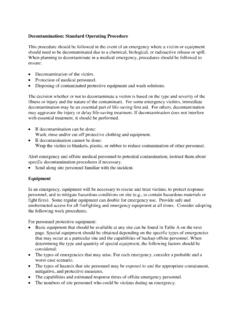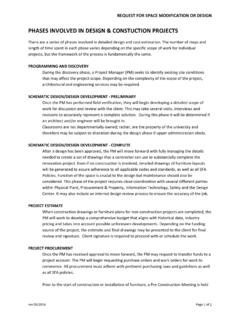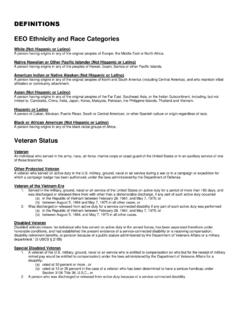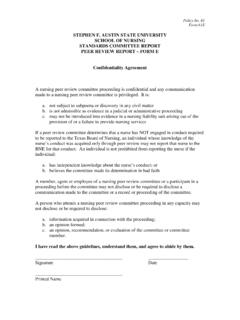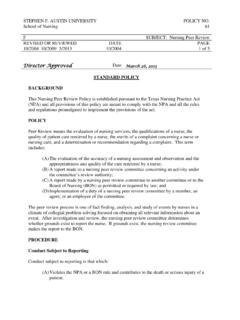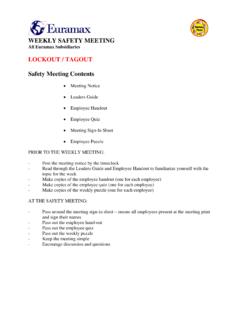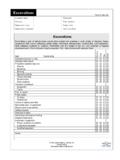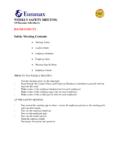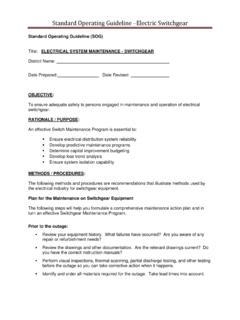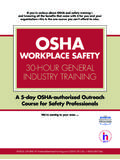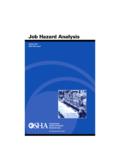Transcription of Employee Safety and Health Training Plan - …
1 Employee Safety and Health Training plan Environmental Health , Safety , and Risk Management Department Box 6113, SFA Station Nacogdoches, Texas 75962-6113 Revised: January 2011 Purpose and Scope This plan establishes the requirements for the Safety and Health Training program at Stephen F. Austin State University. Training is one of the most important elements of any Safety and Health program. Training is designed to enable employees to incorporate safe operating procedures into their job assignments and reinforce Safety policy and procedure. Safety Training also provides an opportunity to communicate Safety principles and commitment of management to a safe work place. This Training plan applies to all new employees and existing Stephen F. Austin State University staff and faculty. Introduction An education and Training plan is one of the most necessary and basic elements of an Employee environmental Health , Safety , and risk management program.
2 Training is essential to communicate practical understanding to employees at Stephen F. Austin State University. A Training program addresses specific Safety and Health responsibilities and provides risk prevention and loss control information for Stephen F. Austin State University employees. Safety Training is most effective when it is immediately incorporated into standard operating procedures, workplace practices, and individual job performance requirements. Training is required for both supervisors and employees alike. The content of each Training session will vary, but each session whether provided by the Environmental Health , Safety & Risk Management Department ( Safety Department) or individual departments on campus will attempt to teach the following: The success of Stephen F. Austin State University s Health and Safety Program depends on the actions of individual employees as well as a commitment by the University.
3 Inform employees about the agency standards, policies and procedures in regard to loss prevention, Safety , and Health . Review the safe work procedures unique to that Employee s job, and how these safe work procedures protect against risk and danger. When personal protective equipment is required or necessary, and how to use and maintain the equipment in good condition. Learn what to do in case of emergencies occurring in the workplace. Direction regarding needs to communicate concerns about loss control or Health and Safety matters. Employee Responsibility for Training Teaching Safety is a two-way street. Stephen F. Austin State University can promote and encourage Safety , but only employees can practice Safety . Safety education requires Employee participation. Remember, the following general rules apply in all situations: No Employee should undertake a job that appears to be unsafe. No Employee is expected to undertake a job until he/she has received adequate Safety instructions, and is authorized to perform the task.
4 No Employee should use chemicals without fully understanding their hazardous or toxic properties and without the knowledge required to work with these chemicals safely. Mechanical safeguards must be kept in place. Employees must report any unsafe conditions to the job site supervisor and the Safety Department. Any work-related injury or illness must be reported to management and the Safety Department at once. Personal protective equipment must be used when and where required. All such equipment must be properly maintained and fitted. Supervisor s Responsibility Supervisors are also vested with special duties concerning the Safety of employees. The supervisors are key figures in the establishment and success of Stephen F. Austin State University s Environmental Health , Safety & Risk Management Program. Supervisors are responsible for being familiar with Safety and Health hazards to which employees are exposed, how to recognize them, the potential effects of these hazards, the rules and procedures for maintaining a safe workplace, and shall investigate accidents.
5 Employee Safety and Health Training Employee Training is probably our most valuable accident prevention tool in developing Employee awareness of Safety . Everyone needs Training at one time or other. New employees need Training to start off on the right foot. Existing employees who are changing jobs require Training to perform their new jobs more efficiently and safely. Training is extremely important for employees assigned to an activity requiring reaching, material handling, use of machinery, and repetitive motion. Supervisors need Training in Safety management techniques to serve as the role models and to ensure employees are performing their assigned tasks in a safe and efficient manner. Retraining of employees at various times is necessary to reinforce Safety procedures and to maintain proficiency in safe task performance. The Safety and Health Training component can be divided into three major categories: new Employee orientation, specialized, and remedial Training .
6 1. New Employee Orientation Training New employees will initially receive Safety information from the Safety Department normally within the first week of employment. This Training will briefly discuss accident/injury procedures, emergency procedures, Hazard Communication awareness, and that additional site specific Safety Training may be required. All new employees are required to attend the Safety Department s New Employee Orientation Training Program before they conduct a Safety sensitive task. This is the first opportunity to establish the expectations for Stephen F. Austin State University s Environmental Health , Safety & Risk Management Program. The following topics should be covered with new employees. 1. SFA s general Safety rules and policies 2. Employees Safety responsibilities 3. Management s support for working safely 4. Hazard Communication & chemical Safety procedures 5. Fire and emergency evacuation plan 6.
7 Workers compensation programs/benefits 7. Procedures for reporting Safety violations, accidents/incident, near-misses 8. Proper lifting & ergonomic techniques 9. Personal protective equipment 10. Use of fire extinguishers After completion of the general Safety orientation class, the new hire s supervisor should also provide additional site specific Training applicable to Safety sensitive tasks before the Employee is allowed to conduct the task. This Training will consist of: 1. Emergency plans, evacuation routes, assembly locations and emergency actions 2. Rules for reporting Safety violations, accidents, and near misses 3. Safe operating procedures 4. Location & use of emergency eyewash and Safety shower stations (if applicable) 5. Location and use of fire alarm pull boxes and fire extinguishers 6. Use of tools & equipment, lifting & material handling equipment 7. Machine & tool guards, emergency stop control locations and use 8.
8 Proper ergonomic procedures & lifting techniques for the tasks assigned 9. Safety equipment & personal protective equipment. 10. Hazard Communication: specific hazards for work area chemicals. 2. Specialized, High Interest Areas, or Specific Subject Matter Training - When an Employee is transferred into a new workgroup or department and is assigned new job duties, specific job instruction Training should be provided by the area supervisor or the Safety Department. Job instruction Training should incorporate Safety concepts into task Training . The Employee should show that he or she is able to perform the task safely before being allowed to perform the task without supervision. Remedial Training at regular intervals may be required. Employees may also receive specialized or high interest Safety Training . This Safety Training may be presented during staff meetings. Specialized or high interest Safety Training normally includes topics such as prevention of repetitive injuries, hazard recognition and avoidance, as well as confined space entry, lock-out tag-out, how work and respirator Training .
9 Specialized Training normally requires more time and in some cases will need to be conducted by professional sources outside the agency. 3. Remedial Training ( Safety Meetings) - If it becomes evident that additional Training is necessary, remedial Training should be provided. The list below details areas that may require additional retraining for employees. 1. Review of Safety Policies and Rules 2. Ergonomics 3. Hazard Communication/Chemical Safety 4. Emergency Action Procedures (including evacuation) 5. Personal Protective Equipment 6. Electrical Safe Work Practices 7. Confined Space Entry & Rescue 8. Respiratory Protection 9. Bloodborne Pathogens 10. Lockout/Tagout Procedures & Machine Guarding 11. Hearing Conservation 12. Fire Safety /use of Fire Extinguishers 13. Chemical, Biological, Radioactive Safety 14. Proper Lifting 15. Hazardous Waste Procedures and Disposal 16. Asbestos 17. Forklift Safety 18. Fall Protection/Ladder Safety 19.
10 Agriculture Safety Documentation and Record Keeping It is essential that all Training be adequately documented. As a minimum the Safety Training /Meeting form below or a similar form should be signed and maintained on file for each Safety Training /meeting. Training records will be filled out by the Employee s immediate supervisor and filed in the Safety Department or the departmental Employees Personnel Record. Stephen F. Austin State University Safety Training /MEETINGS 1. DATE: 2. SUBJECT:_____ 3. MATERIAL COVERED:_____ _____ 4. Training AIDS/EQUIPMENT:_____ 5. PRESENTED BY: _____ 6. ATTENDEES' SIGNATURES: _____ _____ _____ _____ _____ _____ _____ _____ _____ _____ _____ _____ _____ _____ _____ _____ _____ _____ _____ _____ _____



